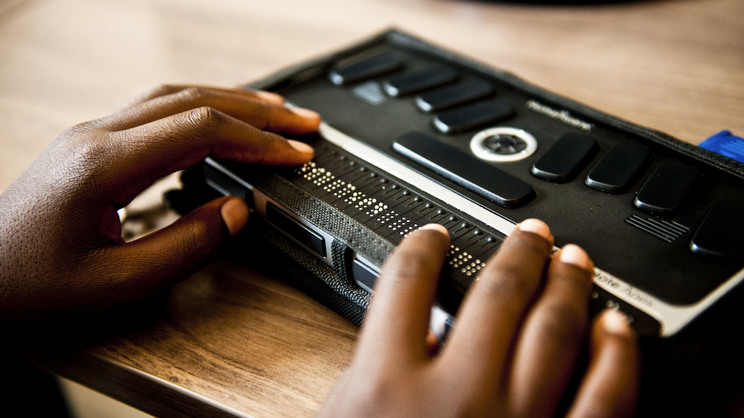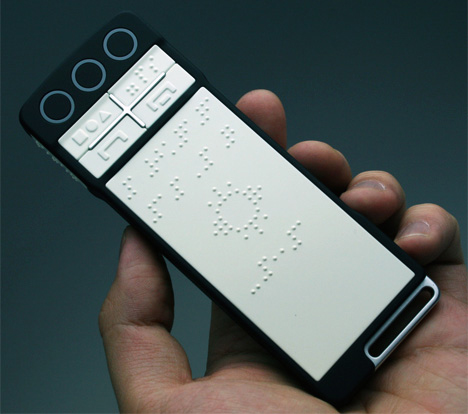Voice-Activated Assistive Devices: Simplifying Daily Tasks
Voice-Activated Assistive Devices: Simplifying Daily Tasks
Blog Article
Discover Cutting-edge Tools Designed for the Aesthetically Impaired
The growth of innovative tools for the visually damaged stands for a significant improvement in access and freedom. Technologies such as smart glasses with AI capacities and mobile applications made to supply acoustic descriptions are reshaping day-to-day experiences for individuals. Furthermore, wearable devices that use haptic comments improve ecological recognition, while contemporary Braille technologies use brand-new methods to engage with text. As these devices proceed to advance, their influence on the lives of those with visual disabilities raises crucial questions concerning the future of inclusivity and freedom in numerous facets of life. What lies ahead in this technical landscape?
Smart Glasses for Navigation

Smart glasses made for navigating are transforming the method visually impaired people connect with their atmosphere. These sophisticated gadgets use a mix of electronic camera technology, fabricated intelligence, and auditory responses to supply real-time details about surroundings. By utilizing obstacle detection systems, smart glasses can inform customers to possible dangers, enabling much safer flexibility in both familiar and strange setups.
The assimilation of GPS technology better boosts navigating capabilities, enabling users to obtain auditory directions as they relocate. This hands-free approach not only cultivates self-reliance but also equips aesthetically damaged people to navigate metropolitan landscapes with increased self-confidence. Furthermore, many smart glasses are outfitted with attributes that identify sites and street signs, supplying contextual details that boosts the user experience.
In addition, the advancement of these tools is continually advancing, with firms functioning to improve the accuracy of item recognition and increase the series of navigational attributes. As smart glasses become extra accessible and budget friendly, they hold the possible to considerably change every day life for aesthetically damaged customers. Eventually, these cutting-edge tools represent an important step towards inclusivity, offering boosted flexibility and a higher sense of freedom for people navigating the world around them.

Mobile Application for Daily Living
Just how can mobile applications boost the lives of aesthetically impaired people? Mobile applications are reinventing the method aesthetically impaired individuals navigate their settings, manage daily tasks, and accessibility information. These applications supply essential assistance via different functionalities, fostering independence and enhancing lifestyle.
Several ingenious mobile apps are developed especially for everyday living. For instance, applications like Be My Eyes connect aesthetically damaged customers with sighted volunteers by means of video clip phone calls, allowing them to receive real-time support with jobs such as reading labels or browsing unknown spaces. Seeing AI, established by Microsoft, makes use of man-made intelligence to describe environments, reviewed message, and determine things, properly changing a smart device into a powerful device for daily help.
Furthermore, navigating applications tailored for the visually damaged, such as Aira and BlindSquare, supply audio-based directions and environmental details, allowing individuals to traverse their environments safely and with confidence. Past navigation and instant help, mobile apps likewise support organization and job monitoring, with attributes that aid customers establish tips, produce to-do lists, and track consultations. In recap, mobile applications work as essential sources, empowering aesthetically damaged people to lead even more independent and fulfilling lives.
Wearable Technologies for Help
Empowerment with modern technology is increasingly noticeable in the world of wearable tools designed to aid visually impaired people. These ingenious tools integrate perfectly right into life, improving navigation and giving vital responses to customers. Clever glasses geared up with electronic cameras can read and identify faces message out loud, enabling users to engage even more with confidence in social and expert setups.
An additional notable advancement is making use of haptic responses systems in wearable devices. These systems utilize vibrations or other responsive signals to communicate details regarding the individual's setting, such as barriers or changes in terrain, enhancing mobility and safety and security. Wearable technologies also consist of wristbands that attach to smartphones, notifying users to notifications with subtle resonances, hence enhancing connectivity without dependence on visual cues.
As these technologies proceed to advance, they are not just improving self-reliance for aesthetically impaired people but also fostering a greater sense of addition in culture. By linking the gap in between difficulties dealt with in day-to-day living and the capacity for freedom, wearable technologies work as critical devices in the mission for equality and empowerment for those with aesthetic disabilities.
Sound Summary Devices
Audio description tools play a vital duty in enhancing availability for aesthetically impaired people, supplying them with the capability to involve with aesthetic media. OCR devices for the blind. These devices offer narrated summaries of crucial aesthetic elements in movies, tv programs, and live efficiencies, ensuring that customers can totally understand the context and emotions conveyed with visuals
Sound description can be incorporated into different systems, including streaming services, movie theater testings, and live theater. Several popular streaming solutions currently include audio summary as an accessibility attribute, allowing visitors to choose it quickly. In addition to conventional media, specialized apps likewise exist, providing audio summaries for art exhibits, museums, and various other cultural occasions.
The performance of audio summary depends upon the ability of the storytellers, that need to convey visual information succinctly without interfering with the initial audio. Innovations in this area are additionally leading the way for even more customized experiences, where individuals can readjust the level of contact lens appointment near me detail and pacing according to their choices.
Braille Innovations and Gadgets
Braille tools and innovations have substantially changed the way aesthetically impaired people interact with message and information. Modern developments have caused the growth of versatile devices that boost literacy and independence among users. Significantly, Braille show modern technologies have evolved, permitting dynamic analysis experiences. These tools convert electronic text right into Braille, allowing customers to access a large array of details on computers, tablets, and smart devices.
In addition, portable Braille notetakers combine traditional Braille input with modern capabilities, promoting note-taking, organizing, and document editing and enhancing on the go. Assistive technology for the blind. These small gadgets commonly feature text-to-speech capacities, connecting the void in between Braille and auditory info
Furthermore, ingenious Braille printers have actually arised, allowing customers to create Braille tags, records, and academic materials efficiently. This availability fosters greater involvement in instructional and professional settings, ultimately advertising inclusivity.
In addition, research study right into clever Braille technologies remains to broaden. Tools that integrate artificial intelligence are being explored to supply real-time navigation help and contextual details, enhancing the customer experience in diverse setups. On the whole, these technologies show a commitment to empowering visually impaired individuals with innovation, ensuring they can easily accessibility and engage with the world around them.

Conclusion
The innovation of cutting-edge tools for the aesthetically damaged dramatically improves freedom and quality of life. Smart glasses, mobile applications, wearable technologies, audio description tools, and Braille advancements jointly encourage people by giving necessary navigating aid, environmental recognition, and improved analysis experiences. These innovations not just foster higher incorporation yet additionally advertise autonomy in everyday activities, inevitably adding to an extra obtainable and fair society for aesthetically damaged individuals. Continued growth in this field holds assurance for additional check my blog enhancements.
As smart glasses come to be much more economical and obtainable, they hold the potential to substantially transform daily life for visually impaired customers. Mobile applications are reinventing the way visually impaired users browse their atmospheres, handle everyday jobs, and gain access to details. Apps like Be My Eyes connect visually damaged individuals with sighted volunteers via video phone calls, permitting them to receive real-time help with jobs such as reviewing labels or navigating unknown areas.Furthermore, navigating applications tailored for the aesthetically impaired, such as Aira and BlindSquare, offer audio-based directions and environmental details, allowing users to traverse their surroundings securely and confidently.The development of ingenious tools for the visually damaged substantially click here now improves self-reliance and quality of life.
Report this page